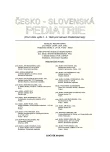Evaluating the Risk of Development of Autoimmune Liver Diseases in Children after Liver Resection
Authors:
O. Petrů 1; J. Bartůňková 2; M. Rygl 1; J. Šnajdauf 1
Authors‘ workplace:
Klinika dětské chirurgie 2. LF UK v Praze, FN Motol, subkatedra dětské chirurgie IPVZ, Praha
přednosta prof. MUDr. J. Šnajdauf, DrSc.
1; Ústav imunologie 2. LF UK , FN Motol, Praha
přednostka prof. MUDr. J. Bartůňková, DrSc.
2
Published in:
Čes-slov Pediat 2005; 60 (4): 200-205.
Category:
Original Papers
Overview
Objective:
Evaluation of the risk of development of autoimmune liver diseases in children, having undergone liver resection for malignant and benign diseases.
Material:
A group of 28 children having undergone liver resection at our workplace in the period of 1991–2002.
Methods:
Analysis of blood samples from children in various periods of time after liver resection and evaluation of the presence of autoantibodies, associated with different types of autoimmune diseases of liver (autoantibodies: ANA – antinuclear, AMA – antimitochondrial, ASMA – against smooth muscles, LKM – antimicrosomes (endoplasmic reticulum) of liver and kidney, ANCA – anticytoplasm of neutrophiles). Dependence of the presence of autoantibodies on the time after operation, age at the time of operation, type of the basal disease and the extent of resection was evaluated. The correlation of positivity of autoantibodies and biochemical signs of liver parenchyma damage was evaluated.
Results:
In the period of 1991–2002, there were 56 liver resection interventions in children with malignant or benign diseases performed at our workplace. At the present time 39 patients are alive (23 boys and 16 girls). Twenty-seven children were operated on and treated with chemotherapy for malignant tumors, 12 children underwent liver resection for benign affections (benign tumors, liver trauma, focal nodular hyperplasia, cholangiogenous cyst). The age at the time of operation was in the range of 0.5 to 14.5 years. The period of observation after the operation is in the range of 1.5 to 13 years and the age of the patients is presently 2 to 23 years.
Twenty-eight patients (16 boys, 12 girls) were examined. The autoantibodies of the ANCA, AMA and LKM were negative in all patients. Antinuclear antibodies (ANA) were positive in one patient (3.6%) with the diagnosis of focal nodular hyperplasia. Autoantibodies against smooth muscles (ASMA) were present in 5 children (17.9%), in the remaining 23 children (82.1%) being undetectable.
In all these five children (boys only) hepatoblastoma was the basal diagnosis and all of them were examined more then 5 years (5–12.5) after liver resection. The positive finding correlated with discrete biochemical symptoms of hepatic lesion (isolated marginal increase in AST, ALT, GMT or bilirubin).
Conclusion:
These results indicate that autoantibodies typical for autoimmune hepatitis of type I (ASMA) occur in children, whose liver resection was made for hepatoblastoma in the time lapse of more then 5 years after the operation. This kind of association excludes the possibility that the formation of autoantibodies is induced only by damage of liver parenchyma during the operation.
The long period of time after the operation and absence of tumor or infection disease at the time of examination does not indicate any possibility of non-specific positivity associated with mechanical damage, infectious or tumor disease. All five children with ASMA displayed discrete symptoms of liver lesion. In view of the absence of symptoms of hepatolysis or marked cholestasis it seems impossible to conclude, whether the presence of ASMA indicates a risk of origin of autoimmune hepatitis at a later time. Based on our results we recommend to invite these patients to regular control examinations.
Key words:
liver resection in children, autoimmune hepatitis, autoantibodies
Labels
Neonatology Paediatrics General practitioner for children and adolescentsArticle was published in
Czech-Slovak Pediatrics

2005 Issue 4
Most read in this issue
- X-linked Hypophosphatemic Rickets
- The Role of Plasma Procalcitonin and Other Inflammatory Markers as Identifiers of Bacterial Infections in Children with Solid Tumor
- Importance of Molecular Genetic Examination for Diagnostics of Wilson Disease
- Intentional Poisoning with Lethal Dose of Imipramine in a 14-year Boy
